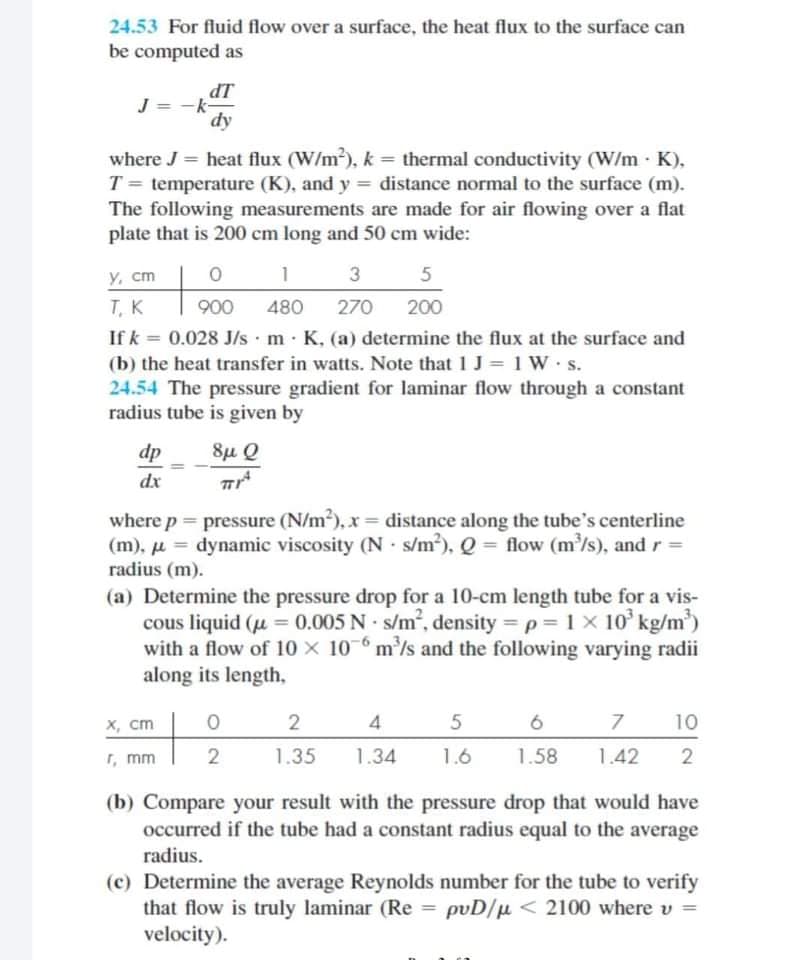24.53 For fluid flow over a surface, the heat flux to the surface can be computed as dT J = -k- dy where J = heat flux (W/m), k = thermal conductivity (W/m K), T = temperature (K), and y distance normal to the surface (m). The following measurements are made for air flowing over a flat plate that is 200 cm long and 50 cm wide: У, ст 1 T, K 900 480 270 200 If k = 0.028 J/s m K, (a) determine the flux at the surface and (b) the heat transfer in watts. Note that 1 J = 1 W s.
24.53 For fluid flow over a surface, the heat flux to the surface can be computed as dT J = -k- dy where J = heat flux (W/m), k = thermal conductivity (W/m K), T = temperature (K), and y distance normal to the surface (m). The following measurements are made for air flowing over a flat plate that is 200 cm long and 50 cm wide: У, ст 1 T, K 900 480 270 200 If k = 0.028 J/s m K, (a) determine the flux at the surface and (b) the heat transfer in watts. Note that 1 J = 1 W s.
Principles of Heat Transfer (Activate Learning with these NEW titles from Engineering!)
8th Edition
ISBN:9781305387102
Author:Kreith, Frank; Manglik, Raj M.
Publisher:Kreith, Frank; Manglik, Raj M.
Chapter8: Natural Convection
Section: Chapter Questions
Problem 8.47P
Related questions
Question
Please answer both question and need so fast. Thank u

Transcribed Image Text:24.53 For fluid flow over a surface, the heat flux to the surface can
be computed as
IP
J = -k-
dy
where J = heat flux (W/m), k = thermal conductivity (W/m · K),
T = temperature (K), and y = distance normal to the surface (m).
The following measurements are made for air flowing over a flat
plate that is 200 cm long and 50 cm wide:
Y, cm
1
5
Т, К
If k = 0.028 J/s·m· K, (a) determine the flux at the surface and
(b) the heat transfer in watts. Note that 1 J = 1 W s.
24.54 The pressure gradient for laminar flow through a constant
radius tube is given by
900
480
270
200
%3!
dp
8µ Q
dx
where p = pressure (N/m), x = distance along the tube's centerline
(m), u = dynamic viscosity (N · s/m3), Q = flow (m/s), and r =
radius (m).
(a) Determine the pressure drop for a 10-cm length tube for a vis-
cous liquid (u = 0.005 N s/m, density = p = 1 x 10' kg/m)
with a flow of 10 x 10-6 m'/s and the following varying radii
along its length,
%3D
х, ст
2
4
10
T, mm
1.35
1.34
1.6
1.58
1.42
(b) Compare your result with the pressure drop that would have
occurred if the tube had a constant radius equal to the average
radius.
(c) Determine the average Reynolds number for the tube to verify
that flow is truly laminar (Re = pvD/µ < 2100 where v =
velocity).
Expert Solution
This question has been solved!
Explore an expertly crafted, step-by-step solution for a thorough understanding of key concepts.
This is a popular solution!
Trending now
This is a popular solution!
Step by step
Solved in 3 steps with 3 images

Knowledge Booster
Learn more about
Need a deep-dive on the concept behind this application? Look no further. Learn more about this topic, mechanical-engineering and related others by exploring similar questions and additional content below.Recommended textbooks for you

Principles of Heat Transfer (Activate Learning wi…
Mechanical Engineering
ISBN:
9781305387102
Author:
Kreith, Frank; Manglik, Raj M.
Publisher:
Cengage Learning

Principles of Heat Transfer (Activate Learning wi…
Mechanical Engineering
ISBN:
9781305387102
Author:
Kreith, Frank; Manglik, Raj M.
Publisher:
Cengage Learning